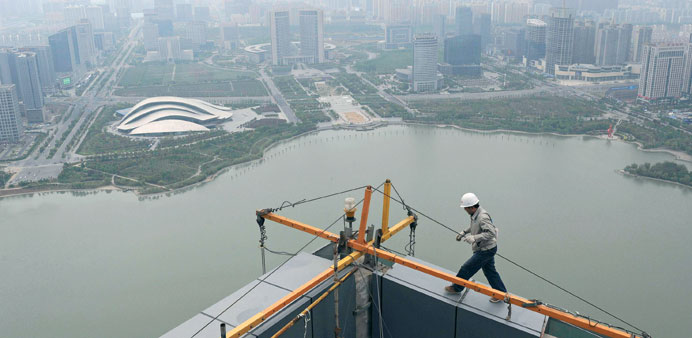|
|
Subdued factory and investment growth probably capped China’s inflation in April and depressed producer prices for a 14th consecutive month, a Reuters poll showed, clouding the outlook for the Chinese economy.
And risks that China’s factory and investment growth in April may miss even conservative forecasts are mounting after surveys of the country’s manufacturing and services industries cooled unexpectedly last month.
A median for forecasts by 27 economists showed the annual consumer price index ran at 2.3% in April, up from 2.1% in March but comfortably below the central bank’s 3% forecast for 2013.
Producer price deflation is forecast at 2.3% compared to a year ago, the deepest in six months.
Analysts from Barclays said China’s struggling exports sector and its fragile domestic demand have added to the problem of capacity under-utilisation, and dampened producer prices.
“The manufacturing sector will face continued pressures from the uncertain external outlook and the modest domestic recovery, and painful adjustments given over-investment and over-capacity,” economists from Barclays said in a note.
China’s factory output is expected to have grown 9.5% in April from a year ago, recovering slightly from a seven-month low hit in March. Fixed-asset investment is forecast to have expanded 21% in the first four months from a year earlier, up a shade from 20.9% between January and March.
But these estimates may prove optimistic.
Two separate surveys of Chinese factories showed growth slowed in April after new export orders fell, reinforcing doubts about the health of the world’s second-biggest economy after its disappointing first quarter.
China’s services sector, having hitherto shown greater resilience than factories, has also faltered.
A private survey yesterday showed growth in the services industry in April plumbed 20-month lows after new orders fell to levels last seen in August 2011. An official survey also showed new orders dropping below historical averages.
The HSBC services Purchasing Managers’ Index (PMI) fell to 51.1 in April from 54.3 in March, with new order expansion the slowest in 20 months and staffing levels in the service sector decreasing for the first time since January 2009.
Two separate PMIs last week had already shown that China’s manufacturing sector growth slowed, with the weakness spreading to services, which make up almost half of gross domestic product, the risk to the recovery may be increasing.
“The weak HSBC service PMI figure provides further evidence of a slowdown not only in the factory sector but also in the service sector,” said Zhang Zhiwei, chief China economist at Nomura Securities in Hong Kong.
“This confirms our worries about insufficient growth momentum in the economy, which we expect to slow to 7.5% in the second quarter.”
The HSBC services PMI follows a similar survey by China’s National Bureau of Statistics, which found non-manufacturing activity eased to 54.5 from 55.6. The official PMI is more weighted towards large state-owned firms.
Readings above 50 indicate activity in the sector is growing, while those below 50 indicate it is contracting.
The HSBC survey showed that the sub-index measuring new business orders dropped sharply to a 20-month low of 51.5 in April, with only 15% of survey respondents reporting an increased volume of new orders that month, HSBC said.
“This started to bite employment growth. All these are likely to add some risk to China’s growth in 2Q, as there’s still a bumpy road towards sustaining growth recovery,” said HSBC’s China chief economist Qu Hongbin.
The employment sub-index decreased to 49.6 in April, the first net reduction in staff numbers since January 2009, although HSBC said job losses were marginal, partially caused by firms down-sizing and employee resignations.
Employment is a decisive factor shaping government thinking because it is crucial for social stability. The services sector accounted for 46% of China’s gross domestic product in 2012, as big as the country’s better-known manufacturing industry.
China’s economic growth unexpectedly stumbled in the first quarter, slipping to 7.7% versus 7.9% in the previous three month period, as factory output and investment slowed.
The government has set a 2013 growth target of 7.5%, a level Beijing deems sufficient for job creation while providing some room to reform to the economy.
Any more weak data could spark a policy response.
“The risk of slower growth is rising, the Chinese government will probably take actions after April data come out,” said Jianguang Shen, chief China economist of Mizuho Securities Asia in Hong Kong.
“I see an increasing possibility for China to cut interest rates, but not likely any time in the near future, as housing inflation is a constraint.”
However a Reuters poll last month found that China’s central bank is expected to keep the benchmark one-year bank lending rate at 6% and the one-year bank deposit rate at 3% through 2013, as well as holding banks’ reserve requirement ratios (RRR) steady.
The dour surveys followed China’s first-quarter growth report that showed its economy stumbling. Growth unexpectedly moderated to 7.7% from 7.9% the previous quarter, hurt by a surprisingly sharp factory cooldown.
Yet most analysts are hopeful China’s economic recovery is merely delayed and has not reversed, with a credit boom underpinning growth. Credit ballooned nearly 60% in the first quarter from a year ago, fuelling future inflation risks.



